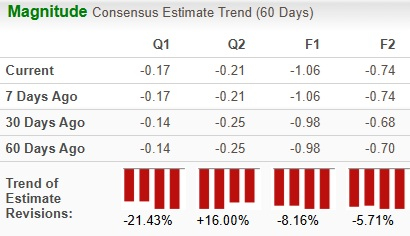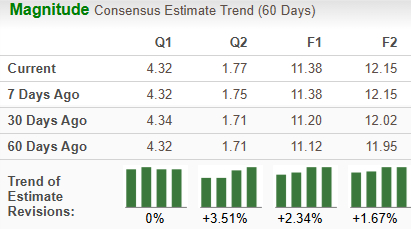|
|
|

|
|||||

|
|
AST SpaceMobile, Inc. ASTS and International Business Machines Corporation IBM are key players in the communications-technology ecosystem. AST SpaceMobile is building the world’s first and only global cellular broadband network in space, accessible directly by standard smartphones (4G-LTE/5G devices) for commercial and government use, leveraging its extensive Intellectual Property and patent portfolio. The SpaceMobile Service is provided by a constellation of high-powered, large phased-array satellites in low Earth orbit (LEO) using low-band and mid-band spectrums controlled by Mobile Network Operators (MNOs) in areas lacking terrestrial network coverage.
IBM offers cloud and data solutions, including enterprise-level networking, cloud and AI infrastructure solutions, which aid enterprises in digital transformation. In addition to hybrid cloud services, the company provides advanced information technology solutions, computer systems, quantum computing and supercomputing solutions, enterprise software, storage systems and microelectronics.
Let us delve a little deeper into the companies’ competitive dynamics to understand which of the two is relatively better placed in the industry.
AST SpaceMobile has deployed its first five commercial satellites (dubbed Bluebird) in LEO, marking a key advancement in developing a space-based mobile network infrastructure. These satellites have the largest-ever commercial communications arrays spanning 693 square feet. They offer non-continuous service across the United States using more than 5,600 cells within the premium low-band spectrum. This achievement follows the success of the company's in-orbit BlueWalker 3 satellite, creating a space-based cellular broadband network that can directly link with mobile devices, eliminating the need for ground-based infrastructure. It plans to deploy 45 to 60 satellites into orbit by the first quarter of 2026. The company boasts a diverse portfolio of more than 3,650 patents and patent-pending claims worldwide for the direct-to-cell satellite ecosystem from space to Earth.
The SpaceMobile service is compatible with all major brands available in the market and connects directly to everyday mobile phones. It delivers broadband connectivity from space to unmodified mobile devices, providing a service to fill cellular coverage gaps in a differentiated approach compared to other space-based communication services. AST SpaceMobile has partnered with leading carriers such as AT&T Inc. T and Verizon Communications Inc. VZ to tap into a pre-existing pool of cell customers and raise funds to help build a worldwide satellite network. This has enhanced cellular coverage in the United States, essentially eliminating dead zones and empowering remote areas of the country with space-based connectivity.
However, unfavorable macroeconomic conditions, including rising inflation, higher interest rates, capital market volatility, tariff imposition and geopolitical conflicts, are negatively impacting the company’s operations. These have led to continued fluctuations in satellite material prices, resulting in increased capital costs and pressure on the company’s financial performance. In addition, AST SpaceMobile faces severe competition from existing and new industry leaders like SpaceX’s Starlink and Globalstar, which are developing satellite communications technology using LEO constellations. To combat such competitive pressure, ASTS has to continuously customize its network offerings, enhance the cost-effectiveness of its products and services and boost the satellite data networks, which increases operating costs and reduces margins.
IBM is poised to benefit from healthy demand trends for hybrid cloud and AI, which drive the Software and Consulting segments. The company’s growth is expected to be aided by analytics, cloud computing and security in the long term. With a surge in traditional cloud-native workloads and associated applications, along with a rise in generative AI deployment, there is a radical expansion in the number of cloud workloads that enterprises are currently managing. This has resulted in heterogeneous, dynamic and complex infrastructure strategies, which have led firms to undertake a cloud-agnostic and interoperable approach to highly secure multi-cloud management, translating into a healthy demand for IBM hybrid cloud solutions.
In addition, the buyout of HashiCorp has significantly augmented IBM’s capabilities to assist enterprises in managing complex cloud environments. HashiCorp’s tool sets complement IBM Red Hat’s portfolio, bringing additional functionalities for cloud infrastructure management and bolstering its hybrid multi-cloud approach.
Despite solid hybrid cloud and AI traction, IBM is facing stiff competition from Amazon’s AWS and Microsoft Corporation’s MSFT Azure. Increasing pricing pressure is eroding margins, and profitability has trended down over the years, barring occasional spikes. The company’s ongoing, heavily time-consuming business model transition to the cloud is a challenging task. Weaknesses in its traditional business and foreign exchange volatility remain significant concerns.
The Zacks Consensus Estimate for AST SpaceMobile’s 2025 sales implies year-over-year growth of 1,142%, while that of EPS suggests a decline of 60.6%. The EPS estimates have been trending southward (down 8.2%) over the past 60 days.

The Zacks Consensus Estimate for IBM’s 2025 sales indicates year-over-year growth of 6.8%, while that for EPS suggests an improvement of 10.2%. The EPS estimates have been trending northward (up 2.3%) over the past 60 days.

Over the past year, AST SpaceMobile has gained 112.2% compared with the industry’s growth of 12.5%. IBM has surged 31.5% over the same period.

IBM looks more attractive than AST SpaceMobile from a valuation standpoint. Going by the price/sales ratio, IBM’s shares currently trade at 3.97 forward sales, significantly lower than AST SpaceMobile’s 78.47.

Both AST SpaceMobile and IBM carry a Zacks Rank #3 (Hold). You can see the complete list of today’s Zacks #1 Rank (Strong Buy) stocks here.
Both companies expect their sales to improve in 2025. However, ASTS’ earnings are likely to decline significantly, while IBM’s bottom line is expected to witness modest growth. IBM has shown a relatively steady revenue growth for years, while AST SpaceMobile has been facing a bumpy road. In terms of price performance, AST SpaceMobile has outperformed IBM but is trading expensively compared to the latter in terms of the valuation metric. With improved estimate revisions, IBM is relatively better placed than AST SpaceMobile and seems to be a better investment option at the moment.
Want the latest recommendations from Zacks Investment Research? Today, you can download 7 Best Stocks for the Next 30 Days. Click to get this free report
This article originally published on Zacks Investment Research (zacks.com).
| 7 min | |
| 54 min | |
| 2 hours | |
| 3 hours | |
| 3 hours | |
| 3 hours | |
| 4 hours | |
| 4 hours | |
| 4 hours | |
| 4 hours | |
| 5 hours | |
| 6 hours | |
| Dec-13 | |
| Dec-13 | |
| Dec-13 |
Join thousands of traders who make more informed decisions with our premium features. Real-time quotes, advanced visualizations, backtesting, and much more.
Learn more about FINVIZ*Elite